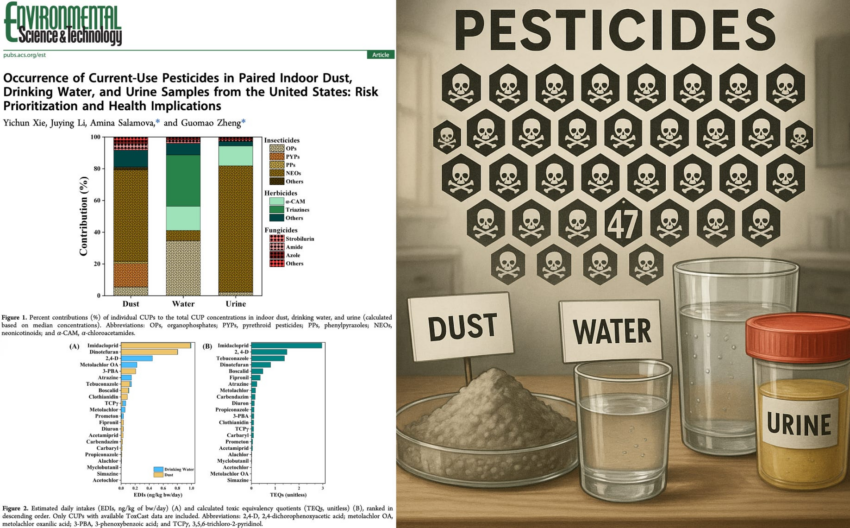A new peer-reviewed study in Environmental Science & Technology has delivered a wake-up call: our homes are not safe havens from pesticide exposure. Researchers tested indoor dust, drinking water, and urine from 81 U.S. households and found that 47 current-use pesticides (CUPs) — including insecticides, herbicides, and fungicides — are now part of our everyday environment and our biology.
Despite being marketed as “safer” replacements for banned legacy pesticides like DDT, these chemicals are emerging as toxic threats to both wildlife and human health, with links to cancer, neurotoxicity, endocrine disruption, and reproductive harm. This was one of the most comprehensive multimedia exposure assessments ever conducted:
Widespread Contamination
Researchers detected 47 of 82 tested pesticides in a multimedia survey of indoor dust, tap water, and human urine from 81 Indiana households.
Median total pesticide concentrations:
-
Indoor dust: 18,300 ng/g — a potent source of chronic inhalation and ingestion exposure.
-
Drinking water: 101 ng/L — showing that contamination reaches the household water supply.
-
Urine: 2.93 ng/mL — clear biological proof of internal absorption.
Neonicotinoids (Bee-Killing Insecticides) in Dust
-
Indoor dust contained neonicotinoid levels up to 3 orders of magnitude higher than in previous urban studies.
-
Imidacloprid — a neonicotinoid linked to cancer-related genetic pathway activation — emerged as the top exposure risk when combining levels found and known toxicity.
Water Supply Heavy with Herbicides
-
Herbicides accounted for 55% of all pesticides in tap water samples.
-
Atrazine and 2,4-D — both linked to cancer, reproductive toxicity, and hormone disruption — were common.
-
13% of drinking water samples exceeded atrazine concentrations associated with adverse birth outcomes.
Proof of Internal Exposure
-
Multiple pesticides detected in human urine, confirming these chemicals are entering and circulating in the body.
-
In urine: insecticides dominated (2.30 ng/mL), followed by herbicides (0.409 ng/mL) and fungicides (0.0531 ng/mL).
Toxicity Rankings
Using EPA’s ToxCast toxicity modeling, the top three highest-risk pesticides (combining exposure and biological activity) were:
-
Imidacloprid – activates cancer-related pathways (CYP, p53, FASN).
-
2,4-D – disrupts reproductive and metabolic pathways (PPARγ, HIF1A).
-
Dinotefuran – disrupts lipid metabolism; linked to childhood obesity in prior studies.
Current U.S. pesticide safety regulations do not account for real-world, combined low-dose exposures, nor for the high pesticide burden from indoor sources such as lawn care chemicals, pet treatments, and household pest control products.
And the gap may soon grow wider: Congress is advancing an Interior-Environment Appropriations Bill with provisions (Sections 453 and 507) that would:
-
Grant sweeping legal immunity to pesticide manufacturers, shielding them from lawsuits by farmers or consumers harmed by their products — even if they concealed known risks.
-
Block states from requiring stronger label warnings than the EPA.
-
Freeze EPA-approved labels for years or decades, making it nearly impossible to update health warnings.
If enacted, these provisions would make it almost impossible to hold chemical companies — including foreign-owned manufacturers — accountable, even when their products cause cancer, reproductive harm, or devastate crops.
For the sake of public health, Congress must reject this bill.
Epidemiologist and Foundation Administrator, McCullough Foundation
www.mcculloughfnd.org
Please consider following both the McCullough Foundation and my personal account on X (formerly Twitter) for further content.
Click this link for the original source of this article.
Author: Nicolas Hulscher, MPH
This content is courtesy of, and owned and copyrighted by, https://petermcculloughmd.substack.com and its author. This content is made available by use of the public RSS feed offered by the host site and is used for educational purposes only. If you are the author or represent the host site and would like this content removed now and in the future, please contact USSANews.com using the email address in the Contact page found in the website menu.











